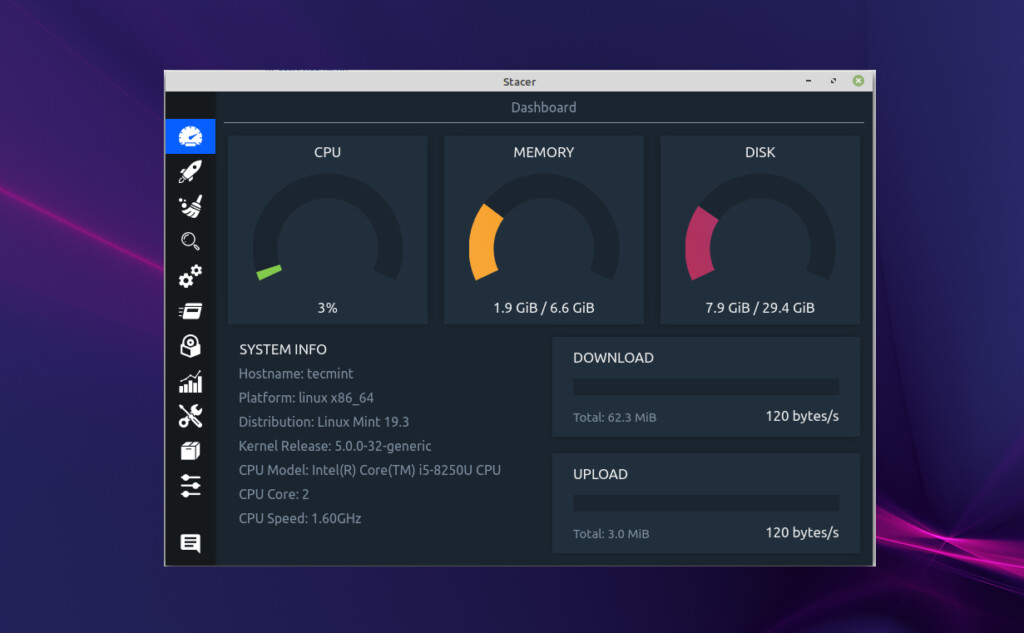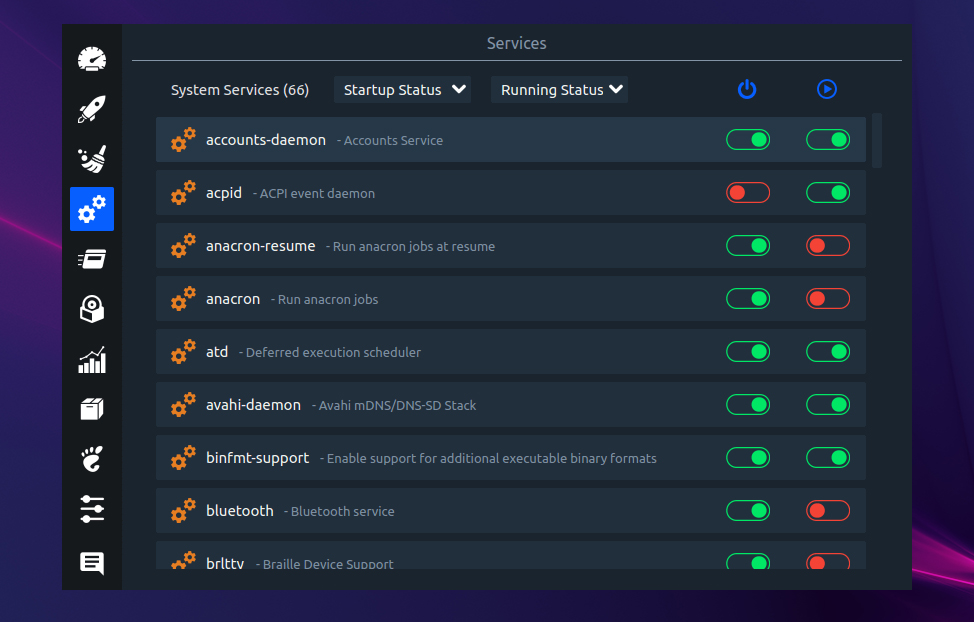On Linux, system monitoring and optimization are often tied to the Terminal and a series of complex commands. Tools like htop, Glances, or systemctl are powerful, but not everyone wants to deal with them daily. Stacer was created to solve this issue: a graphical tool that is intuitive, easy to use, yet powerful enough to help you manage resources, services, and processes efficiently.
Compared to BleachBit, which focuses solely on cleaning junk files, Stacer offers a more comprehensive set of tools—from monitoring CPU, RAM, and disk usage to managing startup applications and system services. If you’re looking for a Terminal alternative for common optimization tasks, Stacer is a compelling option.
1. Why Use Stacer?
With so many Linux monitoring tools available, the question is: What makes Stacer special? The biggest advantage is its user-friendly interface combined with comprehensive features. Stacer is not just a basic system monitor—it also helps you:
- Monitor system resources: Track CPU, RAM, disk, and network bandwidth usage in real-time.
- Optimize performance: Clean up junk files, cache, and system logs.
- Manage processes and services: Easily enable/disable processes and startup applications.
- Uninstall applications: Quickly remove unused software packages.
If you’re used to htop, you might find it more detailed in process tracking, but it lacks application management and system cleaning. BleachBit excels at deleting junk files but doesn’t help with performance monitoring or service management. Stacer combines both, making it a more versatile tool.
A key highlight is that Stacer is perfect for those who want to optimize Linux without relying heavily on the Terminal. Tasks like removing applications, managing services, and controlling processes can take multiple command lines in the Terminal—but with Stacer, everything is just a few clicks away.
2. How to Install Stacer on Linux
Installing on Ubuntu/Debian
Stacer is available through an official PPA, making installation straightforward:
sudo add-apt-repository ppa:oguzhaninan/stacer -y
sudo apt update
sudo apt install stacer -yAlternatively, you can download the .deb package from GitHub:
wget https://github.com/oguzhaninan/Stacer/releases/latest/download/stacer_x64.deb
sudo dpkg -i stacer_x64.deb
sudo apt --fix-broken installThis method is faster since it doesn’t require adding a PPA, but you’ll need to manually update it when a new version is released.
Installing on Fedora/RHEL
For RPM-based distributions, you can download the .rpm package:
wget https://github.com/oguzhaninan/Stacer/releases/latest/download/stacer_x64.rpm
sudo yum localinstall stacer_x64.rpm -ySome systems may require additional dependencies. If you encounter errors when launching Stacer, try running:
sudo dnf install -f3. How to Use Stacer
After installation, you can launch Stacer from the application menu or via the Terminal:
stacerThe main interface is divided into multiple tabs, each corresponding to a critical system function.
3.1. Dashboard – Real-Time System Monitoring
The first tab displays real-time resource usage, including CPU, RAM, disk, and network activity. Instead of typing top or htop, you get a more visual and intuitive overview.

A particularly useful feature is network speed monitoring (Download/Upload) in real-time. If your internet feels slow, this tab helps you check which applications are consuming bandwidth.
3.2. Startup Applications – Faster Boot Time
If your Linux system boots slowly, it might be due to too many background applications. Stacer lets you view and disable startup programs with a single click.
In real-world tests, disabling heavy applications like Slack significantly improved boot times. This is one of Stacer’s best features, as it saves time without requiring manual edits to ~/.config/autostart.
3.3. System Cleaner – Free Up Disk Space
The System Cleaner tab allows you to remove cache, logs, and temporary files. While not as advanced as BleachBit, it provides a simple way to clean essential junk files.

You can select specific file types to delete. For example, if you don’t want to clear your browser cache, you can uncheck that option before cleaning.
3.4. Service Management – Control System Processes
Background services can significantly impact system performance. Stacer helps you enable/disable services with a single click, instead of using systemctl.
If your system is running slowly, checking the service list can help identify unnecessary processes. Some services can be safely disabled to free up system resources.
3.5. Process Management – Control Running Applications
The Processes tab displays all running processes along with their CPU and RAM usage.

A convenient feature is the quick search, allowing you to find a process by name and terminate it instantly. This makes handling unresponsive applications much easier than using:
kill -9 PIDFrequently Asked Questions About Stacer
Does Stacer slow down the system when running in the background?
No. Stacer uses minimal system resources when running in the background and does not significantly impact performance. However, if you keep it open continuously for system monitoring, it may consume some RAM and CPU, similar to any graphical application.
Does Stacer support all Linux distributions?
Stacer supports most major Linux distributions, including Ubuntu, Debian, Fedora, Arch Linux, CentOS, and others. However, some less common distributions may require manual installation or may not be fully compatible.
Can Stacer delete important system files?
No. The System Cleaner feature in Stacer only removes temporary files, cache, logs, and junk files, without affecting critical system files. However, it’s always a good idea to review the files before deleting them to avoid accidental data loss.
Can Stacer replace BleachBit?
Not entirely. While Stacer includes a system cleaning feature, it is not as powerful as BleachBit for securely deleting sensitive data or freeing up disk space thoroughly. If you need basic cleaning, Stacer is sufficient. But if you require deep cleaning (such as permanent file deletion or removing browser traces), BleachBit is a better choice.
Stacer is a powerful tool for monitoring and optimizing Linux. It provides easy resource control, system cleanup, and process management without requiring Terminal commands. However, Stacer doesn’t fully replace the Terminal—advanced tasks like firewall configuration, user management, or deep service adjustments still require command-line interaction.
If you want a comprehensive, user-friendly, and visually appealing tool, Stacer is worth trying. But if you need more detailed resource monitoring, htop or Glances might be a better choice.